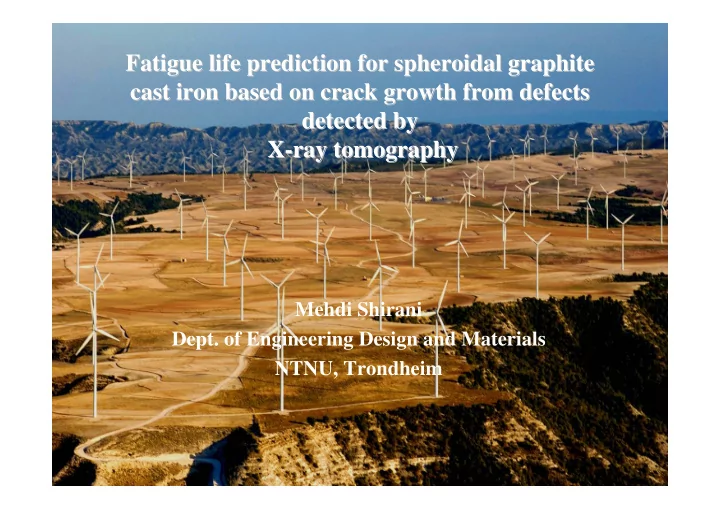

Fatigue life life prediction prediction for spheroidal for spheroidal graphite graphite Fatigue cast iron iron based based on on crack crack growth growth from from defects defects cast detected by by detected X- -ray ray tomography tomography X Mehdi Shirani Dept. of Engineering Design and Materials NTNU, Trondheim
SGCI EN- -GJS GJS- -400 400- -18 18- -LT is used in LT is used in SGCI EN wind- -turbine hubs (Vestas Castings, Kristiansand) turbine hubs (Vestas Castings, Kristiansand) wind 2
FeVIND Main Goal FeVIND Main Goal � To establish methodology and improve data to optimize large wind turbine components (by reducing the weight and increasing fatigue life) 3
Micro- -graph of gas pores in ductile cast iron graph of gas pores in ductile cast iron Micro (Anders Bj Bjö örkblad rkblad, KTH, 2008) , KTH, 2008) (Anders 4
FeVIND FeVIND activities activities 5
P• •FAT FAT P Probabilistic Fatigue Assessment Tool Probabilistic Fatigue Assessment Tool developed at NTNU/IPM 2003- -2007 2007 developed at NTNU/IPM 2003 Material properties Deterministic Probabilistic Crack Growth Implicit FCG analysis Local Stress Weakest Link S-N -curve ( a > 1 mm), ‘crack initiation’ Explicit FCG analysis Single Defect Random Defect d a /d n = f(D s , a ; R ), 6
X- -ray Computed Tomography ray Computed Tomography X cross-sectional image of a Motorbike Casting obtained by Computed Tomography 7
of a CT system a CT system Schematic of Schematic 8
By post processing CT results, it is By post processing CT results, it is possible to access size and location of possible to access size and location of defects defects 9
Using previous data, P • • FAT draws the defects FAT draws the defects Using previous data, P and calculates fatigue life and calculates fatigue life 10
What is the limitation of this method? What is the limitation of this method? � Is it possible to do CT for large parts such as wind turbine Hub? � Due to the limited volume of steel that can be examined by conventional inspection methods, the number and size of defects in a large volume have to be estimated by statistical analysis 11
P • • FAT Random Defect Approach FAT Random Defect Approach P For every finite element of a component, random defects are For every finite element of a component, random defects are generated based on the underlying statistical distributions generated based on the underlying statistical distributions (number, location, size). (number, location, size). 12
Example based on data obtained with a standard with a standard Example based on data obtained optical microscope for EN- -GJS GJS- -400 400- -18 18- -LT LT optical microscope for EN Material Properties Fatigue limit (R=0.1) 150 MPa Tensile strength 403 MPa Yield strength 245 MPa m 4.4 Fatigue Crack Growth data C (R=0.1) 1.878 E -13 Fatigue Crack Growth data Threshold stress intensity 8.56 (MPa, M) range (R=0.1) Defect size shape 0 parameter Defect size location 0.05973 mm parameter Defect size scale parameter 0.05289 mm number of defects per unit 0.05 13 volume
Stress range 243 MPa Stress range 243 MPa, R=0.1, Probability of failure is 80% , R=0.1, Probability of failure is 80% ********************************************************************** � PFAT - Main Result File � � DATE: 27/ 1/ 2009 � TIME: 22: 22: 7 ********************************************************************** � FATIGUE ASSESSMENT MODULE: RANDOM DEFECT � � ********************************************************************** � Operating Finite Element File:C:\PFAT\FEA\SAMPLE12.vtf Residual Finite Element File:None � Crack Growth Model: Short Crack Growth Model � � Number of Analysed Components: 10 � ********************************************************************** Parameters � Reference Load Amplitude: 1.21500000000 � � Reference Mean Load: 1.48500000000 � Reference Residual Load: 0.00000000000 Fatigue Limit (amplitude) [MPa]: 150.000 � Stress Ratio for the Fatigue Limit: 0.100000 � � Critical Crack Depth [mm]: 6.00000 � Crack Growth Exponent: 4.40000 Crack Growth Constant [MPa,m]: 1.878000E-13 � Stress Ratio for the Crack Growth Constant: 0.100000 � � Threshold Stress Intensity Factor Range [MPa,m]: 8.56000 � Stress Ratio for the Threshold Stress Intensity Factor Range: 0.100000 Walker Exponent: 0.780000 � Expected Number of Defects Per Unit Volume: 5.000000E-02 � � Defect Size Distribution: Generalised Extreme\Gumble � Defect Size Location Parameter [mm]: 5.973000E-02 Defect Size Scale Parameter [mm]: 5.289000E-02 � ********************************************************************** � � col1: Component Number � col2: Fatigue Life ********************************************************************** � 1 473286 � � 2 212409 � 3 301548 4 787628 � 5 No Critical Defects � � 6 No Critical Defects � 7 537441 8 552515 � 9 563543 � 14 � 10 434078
Probability of failure vs. stress range obtained by Probability of failure vs. stress range obtained by P • • FAT FAT P Probability of failure vs stress range 120 100 80 % 60 40 20 0 210 220 230 240 250 260 stress range (MPa) 15
16
Recommend
More recommend